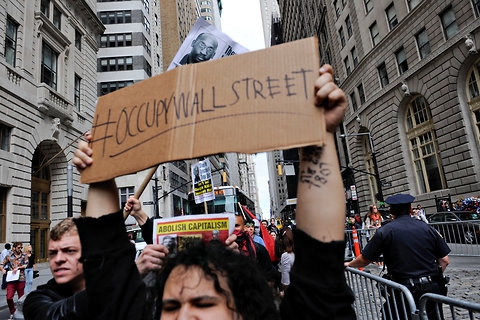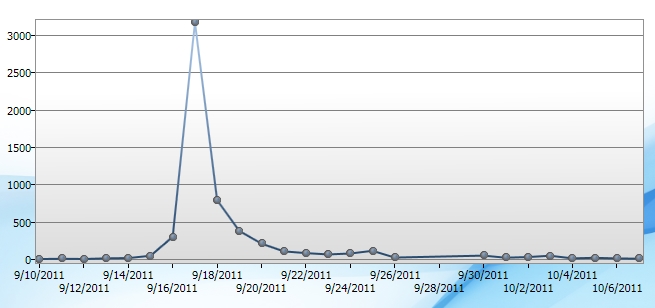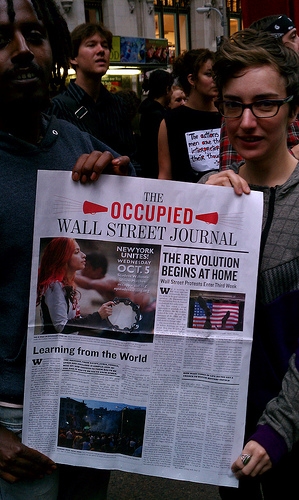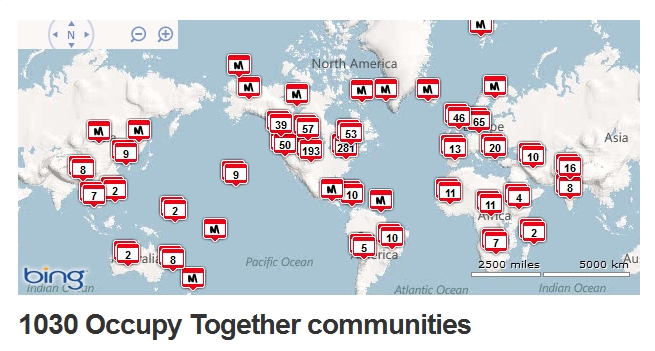
Noticing Identity in Social Movements -- #OccupyWallStreet
It started on Twitter as #DayOfRage. The New York Times report on the first day of protest, September 17, 2011, noted that "day of rage" was used by some of the organizers. (Moynihan, 9/17/2011) The only place #OccupyWallStreet was found in the report was the photo that headed the story.
 |
I collected Twitter messages that contained #DayOfRage from September 10 to October 6. The figure tells one of the elements of the story, of which there are three. First, #DayOfRage could not last if this was going to be a protest aimed at going for weeks or months, which is what the organizers told the Times reporter they had in mind. Day is singular. Months is plural. Second, as is obvious in the figure it did not catch on. September 10 through 16 there were 381 Twitter messages. On the day, September 17, there were 3,162 messages containing #DayOfRage, but the number per day fell very quickly to low teens.
 |
Third, a very large number of the Twitter messages were posted by opponents. These were taken from a single minute, 11:25 CST, on September 16.
Arguing with those criticisms would have been pointless.
#DayOfRage was not going to do as a way of identifying the protest. #OccupyWallStreet already existed, but only 12% of the messages on the 17th contained both #DayOfRage and #OccupyWallStreet. But that changed quickly. After the 17th 39% of the messages contained both.
 |
And a first move in identity was made. It was now #OccupyWallStreet. That was how it came to be known. Wall Street identified the most recent instance of actions of 'the enemy.' They had crashed the economy with illegal business practices, and we had to bail them out. It was a final straw. And the hashtag brought action to the identification of the 'enemy.' Occupy -- it was not demonstrate, it was not protest, it was take over. It was setting up camp for the long haul. That space is going to be ours, and from that space we will march, and protest, and communicate with the world via Twitter, IRC chat, and live streaming, and finally with our own newspaper, The Occupied Wall Street Journal. (Kessler, 10/7/2011)
Fundamental to #DayOfRage and #OccupyWallStreet was the sensibility captured by 99% and 1%. The 1% have been 'taking it all' for three decades. The final blow was the illegal actions leading to the financial crisis of 2008 and 2009. At 10:28 p.m. on October 1 @TheNewDeal posted this message.
0 Bankers Were Arrested After Purposely Crashing Our Economy. Nearly 1,000 Have Been Arrested for Speaking Up About it. #OccupyWallStreet
It was repeated 382 times that evening. The next day, the 2nd, it was repeated 4,215 times. On the 3rd 1278 times, on the 4th 826 times, on the 5th 560 times, on the 6th 75 times, on the 7th 332 times, and on the 8th 270 times. To understand how extraordinary that pattern is it can be compared with the results of a study of all Twitter messages in the fall of 2010. (Sysomos.com, 2010) At that time only 6% of Twitter messages were retweeted. They also found that 92.4% of retweets occurred in the first hour, 1.6% in the second hour, and 1 percent in the third hour. This phrase reverberated through the Twitter messaging of the protestors in quite an extraordinary fashion. It epitomized how they thought about what had and what was happening.
To stand against the establishment, as the people in New York and in many of the other cities did, requires a strong sense of acting together. An identity such as #OccupyWallStreet that we can all adopt is important to the sense of acting together. In addition, Twitter use involves a form of communication that helps build the sense of we. Retweeting can be characterized as the 'we move' in Twitter communication. I read something you write, and then send it along to those who follow me. The form unites you, me, and my followers in a shared communication space. (Boynton, 2011) I found this first in analyzing Twitter communication during the early months of the revolt in Bahrain. Retweeting was more than 60%. The same proved true when I analyzed Twitter messaging in Libya, Syria, Yemen, and Wisconsin [#wiunion]. This should be understood in comparison to standard practice. (Sysomos.com, 2010) There is an extreme difference between standard practice and what was found in those situations of revolt. And it leads to the expectation that one should find something similar here. Retweeting by date is reported in the table.
9/29 |
9/30 |
10/1 |
10/2 |
10/3 |
10/4 |
10/5 |
10/6 |
10/7 |
10/8 |
65.6% |
64.3% |
69.8% |
65.0% |
59.5% |
58.2% |
63.9% |
55.8% |
57.0% |
58.1% |
A second identity move was using "#occupy" but letting the location be local. On the 29th of September the call went out: "We need a map/timeline of all occupations #occupationwallstreet #occupyAtlanta #occupychi, #occupyla #ocupydenver #occupyboston AmericanFall" Protests were constituting themselves in one city after another. #Occupy--- had become sufficiently widespread that a central listing was needed. And later that morning "Move spreads across US, introducing OccupyTogether.org." There was a website acting as a central repository of information about #OccupyWallStreet becoming #Occupy[everywhere]. On October the 4th the website listed 270 sites of #Occupy---. By the 7th the number of sites listed had grown to 1030.
 |
#Occupy--- had become global. Asia, Africa, Europe, South America and all over North America groups took up the cause. And what is telling here is the identification with #OccupyWallStreet by adopting a consistent pattern of identification. It was #OccupyAtlanta, #OccupyChi, #OccupyBoston, and it moved across the world identifying the local protests with the original. It became #OccupyTogether. It became an identity that they could share across the globe.
A third identity move -- When you are fully confident in your identity you can 'play' with it; one way to play is to abbreviate. #OccupyWallStreet was clear. It was the identity they had adopted. It was how they were known. But there is the 140 character constraint, and #OccupyWallStreet is 17 characters. An abbreviation, #OWS, was present from the start, but in small numbers.
| 9/29 | 9/30 | 10/1 | 10/2 | 10/3 | 10/4 | 10/5 |
| 2.0% | 2.2% | 2.4% | 3.0% | 4.3 | 4.9% | 6.8% |
#OWS had been used, but not very often. It was two percent on the 29th and seven percent on the 5th. In the evening of the fifth they made the move.
Shoq 10/5/2011 22:23 Yeah, i was suppsed to write that post. Sorry :) RT @OccupyWallSt: Let's stop the hash tag soup and use #ows for #OccupyWallStreet
Shoq 10/5/2011 22:26 IMPORTANT: @OccupyWallst endorses a tag change from #occupyWallStreet to much shorter #ows http://j.mp/rgEmiu #p2 (RT?)
At 22:23 and 22:26 the word 'went out.' We are going to use #OWS in place of #OccupyWallStreet. And the transition began the next day.
#OccuypWallStreet |
% #Occupy...Plus #OWS |
% #OWS plus #Occupy... |
#OWS |
|
| 10/6/2011 | 83,067 |
11.8% |
26.2% |
57,803 |
| 107/2011 | 69,573 |
18.9% |
26.7% |
69,764 |
| 10/8/2011 | 53,771 |
19.6% |
22.6% |
68,604 |
The first day, October 6, there were 83,067 messages containing #OccupyWallStreet, which was down from 175,177 the day before. But there were also 57,803 messages containing #OWS, which was an increase from 11,949 the day before. The number of messages containing #OccupyWallStreet fell from 83,067 to 53,771 by the eighth, and the number containing #OWS increased from 57,803 to 68,604. Now many messages contain both. A few more days are needed to determine what the transition in identity will become. Perhaps it will be like most of us -- we have a formal and an informal name which we move between with no sense of discontinuity.
Three points to end this story:
1) mhythy 10/9/2011 8:55 AM RT @MutualArising: RT #OWS media team have developed app that one click alerts friends, family & legal you've been arrested http://t.co/GXpEM4xV
There's an app for that. They have created their own app. One click and everyone who needs to know will know you have been arrested. A slightly sad commentary on some policing in the country.
2) Tina Winterlik "OCCUPY- The Whole World is Watching goo.gl/pL6oR #occupywallstreet #occupyvancouver #occupytogether #peace #love #revolution"
Tina Winterlik posted her message from Canada. The whole world is watching, and that is a remarkable turn of events for a protest that started when a few people got together to shout at Wall Street.
3) Editorial, Protesters Against Wall Street, Published: October 8, 2011, The New York Times
As the Occupy Wall Street protests spread from Lower Manhattan to Washington and other cities, the chattering classes keep complaining that the marchers lack a clear message and specific policy prescriptions. The message — and the solutions — should be obvious to anyone who has been paying attention since the economy went into a recession that continues to sock the middle class while the rich have recovered and prospered. The problem is that no one in Washington has been listening.
At this point, protest is the message: income inequality is grinding down that middle class, increasing the ranks of the poor, and threatening to create a permanent underclass of able, willing but jobless people. On one level, the protesters, most of them young, are giving voice to a generation of lost opportunity . . .
A New York Times editorial -- This reflects the respect that has come to them because of the way they have carried out their protest. And because of it becoming a worldwide phenomenon.
So what's the point?
One, it is a good story. A story worth telling and even retelling.
Two, I am interested in how things happen. I am specifically interested in how changing communication structures change practices of politics. And that is what this story is about.
Three, we know that identity is important as groups constitute themselves to stand against those in power. With Twitter we are able to trace the development in a way that has not been possible.
And the final word goes to LillithGrey
LillithGrey, It's a beautiful night for revolution. Someone is passing out cookies. #occupydallas
References
Bennett, W. Lance and Alexandra Segerberg (2011)The Logic of Connective Action: Digital Media and the Personalization of Contentious Politics, paper presented at 6th General Conference of the European Consortium for Political Research.
Boynton, G. R. (2011) Twitter and the Inception of Political Revolts
Kessler, Sarah ( 10/7/2011) Occupy Wall Street Newspaper Raises $54,000 on Kickstarter, Mashablle, http://mashable.com/2011/10/07/occupy-wall-street-newspaper-raises-54000-on-kickstarter/
Moynihan, Colin (9/17/2011) Wall Street Protest Begins, With Demonstrators Blocked, City Room, New York Times. http://cityroom.blogs.nytimes.com/2011/09/17/wall-street-protest-begins-with-demonstrators-blocked/
Sysomos Inc (9/2010) Replies and Retweets on Twitter, Resource Library http://www.sysomos.com/insidetwitter/engagement/
© G. R. Boynton, October 9, 2011